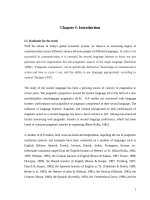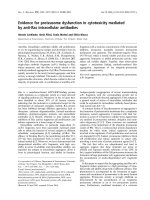Carrier detection in families affected by duchenne muscular dystrophy using multiplex ligation dependent probe amplification (1)
Bạn đang xem bản rút gọn của tài liệu. Xem và tải ngay bản đầy đủ của tài liệu tại đây (3.23 MB, 73 trang )
University of Liege, Belgium
Vietnam National University, Hanoi
JOINT MASTER PROGRAM IN BIOTECHNOLOGY
----------
Nguyen Thi Tuong An
CARRIER DETECTION IN FAMILIES AFFECTED BY
DUCHENNE MUSCULAR DYSTROPHY USING MULTIPLEX
LIGATION-DEPENDENT PROBE AMPLIFICATION
Major: Biotechnology
Code: 60 42 80
MASTER THESIS
SUPERVISOR
PHD., MD. TRAN VAN KHANH
Hanoi, 2013
ACKNOWLEDGEMENTS
This work was supported by The Center for Gene and Protein research.
First of all, I would like to express my greatest appreciation to my
supervisor PhD., MD. Tran Van Khanh, who has offered her continuous
advice and encouragement throughout the course of this thesis.
I am so thankful to committee members their helpful suggestions and
comments for my thesis.
I would like to thank the lecturers of the Vietnam National University
(Viet Nam) and University of Liege (Belgium) for their scientific lectures.
I would also like to thank the leaders and colleagues of the National
Institute for Control of Vaccine and Biologicals (NICVB) for giving me
opportunity to take part in this master program.
I would also like to thank staff members of the Institute of Microbiology
and Biotechnology and The Center for Gene and Protein research, Hanoi
Medical University for making me feel welcome, and providing guidance
whenever I needed it.
To my classmates, a “big” thank you for their friendship and the many
hours of discussions and bouncing of ideas. This is a very special time in my
life and I have learnt much from their sharing.
The most special thanks goes to my family and all of my friends who
always help and support me silently and without their help, I would not have
been able completed this project.
And the last word, I would like to say thank you to the patients and their
families for their cooperation.
Hanoi, November 2013
Nguyen Thi Tuong An
i
ABBREVIATIONS
CK
Creatine Kinase
DGC
Dystrophin-Glycoprotein Complex
DMD
Duchenne Muscular Dystrophy
DNA
Deoxyribonucleic Acid
dNTP
Deoxynucleoside triphosphate
FISH
Fluorescence In Situ Hybridization
MLPA
Multiplex Ligation-dependent Probe Amplification
mRNA
RNA messenger
OD
Optical Density
PCR
Polymerase Chain Reaction
SDS
Sodium Dodecyl Sulfate
ii
LIST OF FIGURES
Figure 1: Typical progression of clinical symptoms with age of DMD patients...............8
Figure 2: Genetic of DMD................................................................................................9
Figure 3: A: location of DMD gene. B: protein products of the DMD gene [35]............11
Figure 4: The dystrophin- associated glycoprotein complex (DGC) in skeletal muscular
[4]..................................................................................................................................12
Figure 5: The steps in PCR ............................................................................................15
Figure 6: Test hybridization on a metaphase from the ................................................18
Duchenne muscular dystrophy carrier [29]...................................................................18
Figure 7: Sequencing of the dystrophin gene ...............................................................19
Figure 8: Outline of the MLPA reaction [46].................................................................20
Figure 9: MLPA results of control and DMD male patient ...........................................21
MLPA electropherograms of DMD male patient showing absence of peaks in DMD
Probe- P034 representing deletion of the exons 21-30 of the Dystrophin gen. Each
peak represents one exon of the Dystrophin gene.......................................................21
1, 2, 3: female at risk of being healthy carrier of DMD (D1, D2, D3).............................37
Figure 10: Family pedigree of patient A........................................................................37
Figure 11: MLPA results of DMD female control (C2) and mother (D1) in using DMD
Probe set P034 the dystrophin gene.............................................................................38
MLPA electropherograms of D1 showing 40-60% reduce of peak areas in DMD Probe
set P034 (MRC- Holland) of the Dystrophin gene representing heterozygous deletion
of the exons 45-50 as compared to the peak areas of MLPA electropherograms of C2
(control sample). The heterozygous deletion of exons 51, 52 in DMD was detected
after probe hybridization with DMD Probe set P035 (data does not shown). Each peak
represents one exon of the dystrophin gene................................................................38
Figure 12: MLPA results of DMD female control (C2) and second aunt (D2) in using
DMD Probe set P034 the dystrophin gene....................................................................39
Figure 13: MLPA results of DMD female control (C2) and first aunt’s daughter (D3) in
using DMD Probe set P034 the dystrophin gene..........................................................40
4, 5, 6, 7: female at risk of being healthy carrier of DMD (D4, D5, D6, D7)...................42
iii
Figure 14: Family pedigree of patient B........................................................................42
Figure 15: MLPA results of DMD male control (C1) and patient B (D8) in using DMD
Probe set P035 the dystrophin gene.............................................................................43
MLPA electropherograms of DMD male patient (D8) showing approximately two-fold
increase of peak areas in DMD Probe set P035 (MRC- Holland) representing
duplications of exons 11-20 and 51-60 of the Dystrophin gene as compared to the
peak areas of MLPA electropherograms of C1 (control sample). Each peak represents
one exon of the dystrophin gene..................................................................................43
Figure 16: MLPA results of DMD female control (C2) and first aunt (D4) in using DMD
Probe set P035 the dystrophin gene.............................................................................44
MLPA electropherograms of D4 showing 30-50% increase of peak areas in DMD Probe
set P035 (MRC- Holland) representing heterozygous duplications of the exons 11-20
and 51-60 of the Dystrophin gene as compared to the peak areas of MLPA
electropherograms of C2 (control sample). Each peak represents one exon of the
dystrophin gene............................................................................................................44
Figure 17: MLPA results of DMD female control (C2) and second aunt (D5) in using
DMD Probe set P035 the dystrophin gene....................................................................45
MLPA electropherograms of D5 showing 30-50% increase of peak areas in DMD Probe
set P035 (MRC- Holland) representing heterozygous duplications of the exons 11-20
and 51-60 of the Dystrophin gene as compared to the peak areas of MLPA
electropherograms of C2 (control sample). Each peak represents one exon of the
dystrophin gene............................................................................................................45
Figure 18: MLPA results of DMD female control (C2) and first aunt’s daughter (D6) in
using DMD Probe set P035 the dystrophin gene..........................................................46
MLPA electropherograms of D6 showing 30-50% increase of peak areas in DMD Probe
set P035 (MRC- Holland) representing heterozygous duplications of the exons 11-20
and 51-60 of the Dystrophin gene as compared to the peak areas of MLPA
electropherograms of C2 (control sample). Each peak represents one exon of the
dystrophin gene............................................................................................................46
Figure 19: MLPA results of DMD female control (C2) and second aunt’s daughter (D7)
in using DMD Probe set P035 the dystrophin gene.......................................................47
Figure 20: MLPA results of DMD female control (C3) and patient E’s mother (D9) in
using DMD Probe set P035 the dystrophin gene..........................................................50
MLPA electropherograms of D9 showing 40-60% reduce of peak areas in DMD Probe
set P035 (MRC- Holland) of the Dystrophin gene representing heterozygous deletion
of the exons 11-20 and 31-40 as compared to the peak areas of MLPA
iv
electropherograms of C3 (control sample). The heterozygous deletion of exons 8-10
and 41-43 in DMD were detected after probe hybridization with DMD Probe set P034
(data does not shown). Each peak represents one exon of the dystrophin gene.........50
......................................................................................................................................50
......................................................................................................................................51
Figure 21: MLPA results of DMD female control (C3) and patient F’s mother (D10) in
using DMD Probe set P035 the dystrophin gene..........................................................51
MLPA electropherograms of D9 showing 40-60% reduce of peak areas in DMD Probe
set P035 (MRC- Holland) representing heterozygous deletion of the exons 11-20 and
31-40 of the Dystrophin gene as compared to the peak areas of MLPA
electropherograms of C3 (control sample). The heterozygous deletions of exons 3-10
and 41-47 in DMD were detected after probe hybridization with DMD Probe set P034
(data does not shown). Each peak represents one exon of the dystrophin gene.........51
Figure 22: MLPA results of DMD female control (C3) and patient G’s mother (D11) in
DMD Probe set P034 the dystrophin gene....................................................................52
MLPA electropherograms of D9 showing 40-60% reduce of peak areas in DMD Probe
set P034 (MRC- Holland) of the Dystrophin gene representing heterozygous deletion
of the exons 48-50 as compared to the peak areas of MLPA electropherograms of C3
(control sample). Each peak represents one exon of the dystrophin gene...................52
LIST OF TABLE
vi
Table 1.1 Genotype of parent and rate of affected in offspring.................................7
Table 1.2 Comparision between Multiplex Ligation dependent Probe Amlification
(MLPA) and other methods...............................................................22
Table 2.1 PCR program for the MLPA reaction.....................................................33
Table 3.1 Results of DNA extraction.....................................................................36
49
50
v
52
52
In all three families, the mothers have a son with DMD so when they intend to have
more children, the prenatal diagnosis is extremely important and
meaningful to prevent birth of affected children.................................53
Table 3.2 Results of multiplex ligation-dependent probe amplification (MLPA).....54
vi
CONTENTS
Hanoi, 2013.............................................................................................................................................i
ACKNOWLEDGEMENTS............................................................................................................................i
ABBREVIATIONS......................................................................................................................................ii
LIST OF FIGURES.....................................................................................................................................iii
LIST OF TABLE.........................................................................................................................................v
ABSTRACT..............................................................................................................................................1
TÓM TẮT.................................................................................................................................................3
PREFACE.................................................................................................................................................5
CHAPTER 1. INTRODUCTION...................................................................................................................7
1.1. Duchenne muscular dystrophy ...................................................................................................7
1.1.1. Characteristics of DMD.........................................................................................................7
1.1.2. Treatment and management of DMD ..................................................................................9
1.2. The dystrophin gene..................................................................................................................10
1.3. Protein dystrophin.....................................................................................................................11
1.4. Mutations in the dystrophin gene.............................................................................................13
1.4.1 Deletion mutations .............................................................................................................13
1.4.2. Point mutations..................................................................................................................13
1.4.3. Duplication mutations........................................................................................................14
1.5. The methods to detection mutations in the dystrophin gene...................................................14
1.5.1. PCR method........................................................................................................................14
1.5.2. Southern blot method .......................................................................................................16
1.5.3. Fluorescence in situ hybridization - FISH............................................................................17
1.5.4. Sequencing method ...........................................................................................................18
1.5.4. Multiplex Ligation- dependent Probe Amplification (MLPA) method ................................19
1.6. The aim of the study..................................................................................................................23
CHAPTER 2. MATERIALS AND METHODS..............................................................................................24
2.1. Samples.....................................................................................................................................24
2.2. Reagents and equipment...........................................................................................................24
2.2.1. Reagents.............................................................................................................................24
2.2.2. Equipment..........................................................................................................................26
2.3. Methods....................................................................................................................................27
2.3.1. Sampling process................................................................................................................27
2.3.2. DNA extraction from blood.................................................................................................27
2.3.3. Calculation of DNA concentration.......................................................................................30
2.3.4. Multiplex Ligation- dependent Probe Amplification (MLPA) method.................................31
CHAPTER 3. RESULTS AND DISCUSSION................................................................................................35
3.1. DNA extraction .........................................................................................................................35
3.2. MLPA results..............................................................................................................................36
3.2.1. MLPA results of patient A’s family......................................................................................36
3.2.2. MLPA results of patient B’s family......................................................................................41
3.2.3. MLPA result of patient E’s mother (D9)..............................................................................49
3.2.4. MLPA result of patient F’mother (D10)...............................................................................50
3.2.5. MLPA result of patient G’s mother (D11)............................................................................51
CONCLUSION AND SUGGESTION..........................................................................................................55
BIBLIOGRAPHY......................................................................................................................................56
ABSTRACT
Duchenne muscular dystrophy (DMD) is a recessive disorder
associated with the chromosome X caused by mutations in the dystrophin
gene. It mostly affects boys, and is characterized by a rapidly progressive
muscle weakness that almost always results in death, usually by 20 years of
age. When a family member has DMD, all member of the family are affected
by caregiving demands and emotional reactions. In Vietnam the socioeconomic burden of disease is very high, as the parents have to cover the cost
of treatment themselves, without much help from the government. Therefore,
prenatal diagnosis is greatly in demand.
According to an analysis of previous studies, two-thirds of cases the
defective gene is passed on to a son through the mother’s faulty X
chromosome; the diagnosis of female carriers (mother, aunt, sister) to detect
mutations which would enable medical staff to provide prenatal genetic
counseling for them is the most effective solution to reduce incidence. Many
methods have been used to help the detection of heterozygous females, such
as PCR, Southern blot, FISH, etc, in which, MLPA is increasingly become
widely used in laboratories worldwide. With many advantages such as rapid,
sensitive, cost effective and reliable so MLPA is the first option and is a
useful quantitative method for detecting mutation for the analysis of both
affected males and female carriers.
In this study, we have succeeded in the application of the MLPA
method to identify female carriers. We detected 7 out of 10 female carriers in
5 affected DMD families. Four of them show heterozygous deletion exons 4552, 8-43, 3-47 and 48-53, in the DMD gene, respectively. The remaining three
1
female carriers have heterozygous duplication exons 11-20 and 51-60 in the
DMD gene. In addition, we also detected one patient with duplication exons
11-20 and 51-60 in the gene. The normal control samples show no deletions
in any of the exons tested. MLPA assays are performed according to
manufacturer recommendations.
2
TÓM TẮT
Tên luận văn: "Ứng dụng kỹ thuật Multiplex Liagation-dependent Probe
Amplification để xác định người lành mang gen bệnh trong các gia đình bị
ảnh hưởng bởi bệnh loạn dưỡng cơ Duchenne".
Người hướng dẫn: TS. BS Trần Vân Khánh
Trung tâm nghiên cứu Gen- Protein, Trường đại học Y Hà Nội.
Ngành: Công nghệ Sinh học
Chuyên ngành: Công nghệ Sinh học
Mã số: 604280
Bệnh loạn dưỡng cơ Duchenne (Duchenne Muscular DystrophyDMD) là bệnh di truyền lặn liên kết với nhiễm sắc thể X gây ra bởi đột biến ở
gen dystrophin. Căn bệnh này chủ yếu ảnh hưởng đến trẻ em trai, nó đặc
trưng bởi yếu cơ tiến triển nhanh và phần lớn bệnh nhân chết ở tuổi 20. Khi
có một thành viên trong gia đình mắc bệnh DMD, các thành viên khác của gia
đình đó cũng bị ảnh hưởng bởi nhu cầu chăm sóc và những phản ứng tâm lý.
Ở Việt Nam, gánh nặng về mặt kinh tế, xã hội của bệnh là rất cao do đó các
bậc cha mẹ phải tự trang trải các chi phí điều trị cho con em mình mà không
có sự giúp đỡ từ chính phủ. Chính vì vậy, việc chẩn đoán trước khi sinh là yêu
cầu cấp thiết.
Theo một số nghiên cứu, khoảng hai phần ba số trường hợp gen khiếm
khuyết được truyền sang con trai từ người mẹ có nhiễm sắc thể X bị lỗi; chẩn
đoán người nữ dị hợp tử (mẹ, cô, dì, chị em gái) để phát hiện các đột biến sẽ
cho phép nhân viên y tế tư vấn di truyền trước khi sinh là giải pháp hiệu quả
nhất để giảm tỷ lệ mắc căn bệnh này. Có nhiều phương pháp được sử dụng để
giúp phát hiện người nữ dị hợp tử, chẳng hạn như PCR, MLPA, Southern
blot, FISH, …. trong đó MLPA là kỹ thuật ngày càng được sử dụng rộng rãi
trong các phòng thí nghiệm trên toàn thế giới. Với nhiều ưu điểm như nhanh
3
chóng, chính xác, độ nhạy cao và chi phí hiệu quả nên MLPA là sự lựa chọn
đầu tiên và là phương pháp định lượng hữu ích để phát hiện đột biến ở cả nam
giới bị bệnh và người nữ mang gen bệnh.
Trong nghiên cứu này, chúng tôi đã thành công trong việc áp dụng
phương pháp MLPA để xác định người nữ dị hợp tử. Chúng tôi phát hiện
được 7 phụ nữ có mang gen dị hợp tử trong số 10 phụ nữ ở 5 gia đình bị ảnh
hưởng bởi bệnh DMD. Bốn người trong số họ có đột biến xóa đoạn dị hợp tử
ở các exon 45-52, 8-43, 3-47 và 48-53; ba người còn lại có đột biến lặp đoạn
dị hợp tử ở các exon 11-20 và 51-60 trong gen dystrophin. Ngoài ra, chúng tôi
cũng phát hiện một bệnh nhân có đột biến lặp đoạn ở các exon 11-20 và 51-60
trong gen dystrophin. Các mẫu chứng hiển thị đầy đủ các exon. Kỹ thuật
MLPA được thực hiện theo khuyến nghị của nhà sản xuất.
4
PREFACE
Duchenne muscular dystrophy (DMD) is one of the most common fatal
genetic disorders affecting children around the world (every ethnicity and
geographic location). It affects approximately 1 in every 3,500 boys, or 20,000
live male births each year worldwide [13], [52]. The causes of DMD are
mutations in the dystrophin gene on chromosome X; hence, it is diagnosed mostly
in males. In Vietnam, the frequency of occurrence of this disease does not have
official statistics.
All the DMD patients are males since females are heterozygous
carriers; they lose the ability to walk because of inability produce dystrophin,
a protein necessary for muscle strength and function. As a result, every
skeletal muscle in the body deteriorates. Although DMD is the most common
fatal genetic disorder to affect children, at the moment no cures have been
found. This disease causes serious health problems and significant economic
burdens. Researchers are still looking for treatments to alter the course of the
disease and improve the quality of life for patients. Previous studies have
shown that two thirds of patients receive the mutation from their mothers and
the other one third has new mutation [14], [19], [47], [54]. Thus, detection of
the heterozygous status of mother as well as other female members of family
with suitable consequent antenatal screening of the fetus at risk is highly
appreciated active prevention (reduces new incidence of the disease). In
Vietnam, routine molecular genetic testing used to detect mutations includes:
Polymerase Chain Reaction- PCR (Multiplex PCR), Southern blots, etc.
However, these methods require a long time to detect mutations on the entire
79 exons; it takes about 3-4 weeks, normally. In recent years, many studies
show that Multiplex Ligation- dependent Probe Amplification (MLPA) is a
rapid and accurate technique, which allows high-throughput screening
5
mutations, especial deletions and duplications, in DMD and other genetic
diseases. This is a molecular biology method based on the basic principle of
PCR; nonetheless, it uses one pair of primer to amplify all probe ligation
products. Τηισ τεχηνιθυε ωασ περφορµεδ ωιτη 2 reactions: MLPA-P034 (DMD exon
1-10, 21-30, 41-50 and 61-70) and MLPA-P035 (DMD exon 11-20, 31-40,
51-60 and 71-79). Each reaction amplifies of 50% total exons so that 79 exons
of the dystrophin gene will be amplified in 2 reactions. Thus, within 1 week,
MLPA can screen all mutations in the dystrophin gene. This is a particular
advantage of the MLPA compared with other methods. In order to carry out
the diagnosis, prognosis and genetic counseling for female carriers, we carry
out the study: "Carrier detection in families affected by Duchenne
muscular dystrophy using Multiplex Ligation- dependent Probe
Amplification”.
6
CHAPTER 1. INTRODUCTION
1.1. Duchenne muscular dystrophy
1.1.1. Characteristics of DMD
Duchenne muscular dystrophy (DMD) was first described by Duchenne
de Boulogne, the French neurologist, in the 1860s. Although the disease was
discovered a long time ago, as recently as the early 1980s, people still did not
understand the cause of any form of muscular dystrophy. In 1986, researchers
discovered the gene mutation causing DMD and the protein associated with
this gene was identified and named dystrophin by Hoffman in 1987 [17].
DMD is an X-linked recessive disease caused by mutations in the DMD
gene [56]. Genetically, it complies with the rules of the genetic chromosome
X-linked recessive inheritance so that it mostly affects boys. Females have
two X chromosomes: one X chromosome has the faulty DMD gene while
other contains a normal gene, which compensates for the faulty one. In
contrast, males have only one X chromosome so that they always show
symptoms of the disease. Therefore, the DMD was found to be rather more
common in males than females.
Table 1.1 Genotype of parent and rate of affected in offspring
Genotype and
phenotype of parent
Father
Mother
XDY
XDXD
XDY
XDXd
XDY
XdXd
d
XY
XDXD
XdY
XDXd
XdY
XdXd
The rate of offspring with difference genotypes
Male
Female
D
d
D D
X Y
XY
X X
XDXd
XdXd
1
0
1
0
0
0
½
½
½
½
0
1
0
1
0
1
0
0
1
0
0
½
½
½
½
0
1
0
0
1
Legend:
XDXD: unaffected female
XDXd: carrier female
XdXd: affected female
XDY: unaffected male
XdY: affected male
7
DMD is a progressive disease in which the patient's muscle injury is
due to a lack of dystrophin protein. The disease gradually weakens the
skeletal muscles which are the muscles in the arms, legs and trunk. At first,
boys begin to show signs of weakness when they are 3-5 years old, for
example they are slow runners and have difficulty jumping. From 7- 9 years
old, they have trouble climbing stairs, followed by a complete loss of
ambulation by age 11 [11]. At the onset of their teenage years or even sooner,
they are affected by diseases relating to the heart, respiratory system, nervous
system and this eventually leads to death, typically in their twenties [15], [39].
Figure 1: Typical progression of clinical symptoms with age of DMD patients.
Resouce: />The dystrophin gene can be passed on from the carrier woman to her
child (complies with the rules of the genetic X- linked inheritance). According
to Mendelian inheritance, there is 50% chance a mother who carries the DMD
gene can pass the X chromosome carrying DMD mutated gene to the sons and
they will develop disease and 50% chance that her daughters will carry the
gene. A carrier mother may or may not pass on the gene with the mutation
(figure 2).
8
Figure 2: Genetic of DMD
Resource: />Normally, the majority of female carriers usually have no symptom.
However, 2-20% of carriers have symptoms of muscle weakness or clinical signs
of disease. Norman (1989) suggested that about two- thirds of healthy carriers
have increased serum CK (Creatine kinase) activity [37]. This is an enzyme that
leaks out of damaged muscle so that elevated levels of CK indicate that muscle
tissue is being destroyed. It allows anticipation and early detection of DMD
patients and female carriers because serum creatine kinase activity is increased (210 times the upper limit of normal) in 53 % carriers of DMD [18], [37].
1.1.2. Treatment and management of DMD
It is nearly 30 years since the discovery of the genetic defect causing
DMD, but the disease has yet to be cured. To date, corticosteroids are the only
9
medication that has been shown to be effective in DMD patients [5], [55].
However, the specific mechanisms by which corticosteroids improve strength
in DMD are not known [59]. Accordingly, before using, the potential risks
and benefits of this medical intervention need to be adequately investigated.
In addition, researchers have made great advances in their knowledge of
DMD and continue to search for a cure. At present, some areas in which
research is being focused include: gene therapy, read-through stop codon
strategies, stem cell therapy, vival vectors and utrophin [59]. Nonetheless,
these methods are only of partial support for patients and they are not the
complete cures. Therefore, diagnosis of women with a high risk and genetic
counseling for female carriers in patients’ families are still the best options to
aid in the prevention of this disease [32], [39]. In addition, a healthy lifestyle,
exercise and medication can contribute to a better quality of life for those with
the disease.
1.2. The dystrophin gene
The dystrophin gene is the largest known human gene. It is located on
short arm of the X- chromosome at position Xp21.2 spaning approximately
2400 kb, consists of 79 exons and produces a 14.6 kb mRNA [6], [8], [17],
[64]. It is also composed of at least 7 alternative promoters: brain (B)
promoter, muscle (M) promoter, cerebellum promoter, promoter Dp 260, Dp
140, Dp 116, Dp 71, leading to a number of different isoforms (Figure 3)
[35].
10
Figure 3: A: location of DMD gene. B: protein products of the DMD gene [35]
1.3. Protein dystrophin
The product of the dystrophin gene is dystrophin protein. A complete
understanding about the functions of protein dystrophin is important for the
diagnosis of dystrophinopathies. Dystrophin is a hydrophobic, rod-shaped
protein that is found typically in muscles and is used for muscle movement. It
is encoded by the DMD gene and it has a molecular weight of 427 kDa, and
contains about 3685 amino acids [17], [23]. This protein is located in the
plasma membrane of muscle cells and is divided into four domains [23]:
•
The amino-terminal domain
•
The central- rod- domain
•
The cystein- rich domain
•
The carboxy- terminal domain
11
The first domain is the amino-terminal domain. It has homology with αactin and contains between 232 and 240 amino acid residues depending on the
isoform. The larget domain of dystrophin is the central-rod- domain and it is a
succession of 25 triple-helical repeats similar to spectrin and contains about
3000 residues. The third domain is a cysteine- rich domain of 280 residues.
The finally- carboxy-terminal domain comprises 420 residues [35].
Figure 4: The dystrophin- associated glycoprotein complex (DGC) in
skeletal muscular [4]
Dystrophin plays an important structural role as part of a large complex
in muscle fiber membranes. It provides a structural link between the muscle
cytoskeleton and extracellular matrix to maintain muscle integrity [7], [42].
Many membrane proteins associated with dystrophin protein complex are
made up of DGC (dystrophin-glycoprotein complex). One of the other main
roles of the DGC is to stabilise the sarcolemma and to protect muscle fibres
12
from long-term contraction-induced damage and necrosis [35]. Moreover, the
DGC may also play a role in cell signaling by interacting with proteins that
send and receive chemical signals. The signal loss can also contribute to
causing the disease [17], [41]. When dystrophin is absent, the DGC is
destabilized leads to muscle wasting which characterizes Duchenne muscular
dystrophy.
1.4. Mutations in the dystrophin gene
Mutations in the large dystrophin gene, which consists of 79 exons
generally causes a disruption of the open reading frame in the dystrophin
protein production process which leads to progressive muscle degeneration
[1], [34] There are 3 main types of mutation in the dystrophin gene:
- Deletion mutations
- Point mutations
- Duplication mutations
Deletions, duplications and point mutations have been reported in most
exons of this gene.
1.4.1 Deletion mutations
Deletion one or several exons is common mutations in patients with
DMD, accounting for 60-65% of DMD disease-causing mutations [9].
Deletion mutations in DMD genes are the most commonly found intragenic
deletions and concentrated in two known "hot spot" regions; one is located the
5' end (exons 2-20) and the other is located near the central portion of the
gene (exons 44- 53) [9], [22].
1.4.2. Point mutations
Point mutation, accounting for 25-30%, is the second largest mutation in
the dystrophin gene after deletion mutations [43]. Most point mutations in the
DMD gene created stop codon and caused seriously disease. Point mutations are
13
located along the entire gene and this is a major obstacle in identifying these
mutations. Currently, over 200 point mutations of the dystrophin gene have been
identified [38], [43].
1.4.3. Duplication mutations
Duplication mutations are the cause of DMD in most of the remaining
cases (approximately 5%-15%). Prior (2005) suggested that 80% of mutations
occur in the 5 'end and 20% in the center. In addition, a small percentage of
DMD patients have small mutations scattered along the length of the entire gene
making them difficult to detect [39].
1.5. The methods to detection mutations in the dystrophin gene
As mentioned above, there is currently no cure for DMD. Thus prenatal
diagnosis and detection of the carrier is the best approach to reduce the
burden of disease for the family in particular and society in general. Several
molecular diagnostic techniques have been applied to detect these mutations
all over the world and Vietnam. Some of them are listed below:
1.5.1. PCR method
PCR (polymerase chain reaction) was invented by Kary Mullis in the
mid-1980s to multiply DNA in in-vitro conditions. This technique has created
a revolution in molecular genetics and is widely used in the laboratory for
biological research. It is based on the synthesis of a target DNA segment
under the catalysis of the enzyme DNA-polymerase (taq polymerase), and
occurs in repeated cycles. Components in the PCR reaction include DNA
sample, deoxynucleotide triphosphate (dATP, dGTP, dCTP, dTTP), MgCl 2,
primers, DNA polymerase and PCR buffer solution [33].
PCR is a three-step process that is carried out in repeated cycles.
Step1 (initial or denaturation stage): The initial step is the denaturation
or separation of the two strands of the DNA molecule. This is accomplished
14
by heating the starting material to temperatures of about 94°- 95° C. Each
strand is a template on which a new strand is built. This step takes place in the
range of 30-60 seconds.
Step 2 (annealing stage): In the second step the temperature is reduced
to about 55° C so that the primers can anneal to the template. Annealing
temperature is lower and depends on the length of the primers. This step takes
place in the range of 30-60 seconds.
Step 3 (synthesis or extended stage): In the third step the temperature is
raised to about 72° C, and the DNA polymerase begins adding nucleotides
onto the ends of the annealed primers. This step takes place in the range of 30
seconds to several minutes.
Figure 5: The steps in PCR
Resource: Andy Vierstraete (1999)
15
The number of cycles per PCR reaction depends on the initial number of
DNA template, usually, does not exceed 40 cycles. Normally, 25 to 30 cycles
produces a sufficient amount of DNA. The number of copies doubles after each
cycle. So, after n cycles, a target DNA is cloned into 2n copies [33].
PCR technique is a key contributor in the development of molecular
biology techniques. Simple, economy (personal, time, material) and a high
degree of sensitivity are the advantages of this technique. With its enormous
potential, PCR techniques are widely used in many different fields in both
science and in social life. In medicine, PCR can deliver a fast and accurate
diagnosis of genetic diseases and genetic factors involved. Particularly in the
case of DMD, PCR plays an especially important role in the process of
mutation detection. Several techniques such as multiplex PCR, Nested PCR,
RT-PCR have been used to detect mutations are based on the principle of
PCR. Among these methods, multiplex PCR is appreciated in the diagnosis of
deletion and about 98% of deletions are easily detectable using multiplex
PCR in affected males [3]. However, for detection of mutations in the
dystrophin gene by PCR at the DNA level, we must amplify the entire 79
exons. To design 79 primer pairs at both ends of each specific exon is both
costly and time consuming. This is a limitation of this method.
1.5.2. Southern blot method
Southern blot is a method used in molecular biology for detection of a
specific DNA sequence in DNA samples. The principle in this method
combines agarose gel electrophoresis for size separation of DNA with
methods to transfer the size- separated DNA to a filter membrane for probe
hybridization. The method is named after its inventor, the British biologist
Edwin Southern. Southern blot is not only applied to detect deletion
16








